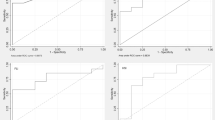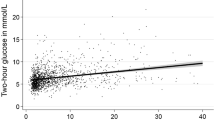Abstract
Objectives
The SteatoTest, fatty liver index (FLI) and hepatic steatosis index (HSI) are clinico-biological scores of steatosis validated in general or selected populations. Serum adiponectin (s-adiponectin) and retinol binding protein 4 (s-RBP4) are adipokines that could predict liver steatosis. We investigated whether the Steatotest, FLI, HSI, s-adiponectin and s-RBP4 could be valid predictors of liver steatosis in type-2 diabetic (T2D) patients.
Methods
We enrolled 220 consecutive T2D patients. Reference standard was 3.0 T 1H-MR spectroscopy (corrected for T1 and T2 decays). Intraclass correlation coefficients (ICCs), Kappa statistic measures of agreement, receiver operating characteristic (ROC) curves were assessed.
Results
Median liver fat content was 91 mg triglyceride/g liver tissue (range: 0–392). ICCs among the Steatotest, FLI, HSI, s-adiponectin, s-RBP4 and spectroscopy were low: 0.384, 0.281, 0.087, −0.297 and 0.048. Agreement between scores and spectroscopy was poor (Kappa range: 0.042–0.281). The areas under the ROC curves were low: 0.674, 0.647, 0.637, 0.616 and 0.540. S-adiponectin and s-RBP4 levels were strongly related to the presence of diabetic nephropathy (P = 0.0037 and P = 0.004; Mann–Whitney).
Conclusion
The SteatoTest, FLI, HSI, s-adiponectin, s-RBP4 are not valid predictors of steatosis in T2D patients. Clino-biological markers cannot replace 1H-MR spectroscopy for the assessment of liver fat in this population.
Key Points
• 1 H-MR spectrosopy can reliably estimate the weight fraction of liver steatosis
• Type-2 diabetes provides an interesting model for assessing liver steatosis
• Clinico-biological markers seem to be invalid predictors for steatosis in type-2 diabetes



Similar content being viewed by others
References
Browning JD, Szczepaniak LS, Dobbins R et al (2004) Prevalence of hepatic steatosis in an urban population in the United States: impact of ethnicity. Hepatology 40:1387–1395
Wieckowska A, McCullough AJ, Feldstein AE (2007) Noninvasive diagnosis and monitoring of nonalcoholic steatohepatitis: present and future. Hepatology 46:582–589
Johnson NA, Walton DW, Sachinwalla T et al (2008) Noninvasive assessment of hepatic lipid composition: Advancing understanding and management of fatty liver disorders. Hepatology 47:1513–1523
de Moura AA, Cotrim HP, Barbosa DB et al (2008) Fatty liver disease in severe obese patients: diagnostic value of abdominal ultrasound. World J Gastroenterol 14:1415–1418
Saadeh S, Younossi ZM, Remer EM et al (2002) The utility of radiological imaging in nonalcoholic fatty liver disease. Gastroenterology 123:745–750
Kotronen A, Peltonen M, Hakkarainen A et al (2009) Prediction of non-alcoholic fatty liver disease and liver fat using metabolic and genetic factors. Gastroenterology 137:865–872
Longo R, Pollesello P, Ricci C et al (1995) Proton MR spectroscopy in quantitative in vivo determination of fat content in human liver steatosis. J Magn Reson Imaging 5:281–285
Szczepaniak LS, Babcock EE, Schick F et al (1999) Measurement of intracellular triglyceride stores by H spectroscopy: validation in vivo. Am J Physiol 276:E977–E989
van Werven JR, Marsman HA, Nederveen AJ et al (2010) Assessment of hepatic steatosis in patients undergoing liver resection: comparison of US, CT, T1-weighted dual-echo MR imaging, and point-resolved 1H MR spectroscopy. Radiology 256:159–168
Chalasani N (2009) Nonalcoholic fatty liver disease liver fat score and fat equation to predict and quantitate hepatic steatosis: promising but not prime time! Gastroenterology 137:772–775
Poynard T, Ratziu V, Naveau S et al (2005) The diagnostic value of biomarkers (SteatoTest) for the prediction of liver steatosis. Comp Hepatol 4:10
Bedogni G, Bellentani S, Miglioli L et al (2006) The Fatty Liver Index: a simple and accurate predictor of hepatic steatosis in the general population. BMC Gastroenterol 6:33
Lee JH, Kim D, Kim HJ et al (2010) Hepatic steatosis index: a simple screening tool reflecting nonalcoholic fatty liver disease. Dig Liver Dis 42:503–508
Kantartzis K, Rittig K, Balletshofer B et al (2006) The relationships of plasma adiponectin with a favorable lipid profile, decreased inflammation, and less ectopic fat accumulation depend on adiposity. Clin Chem 52:1934–1942
Stefan N, Hennige AM, Staiger H et al (2007) High circulating retinol-binding protein 4 is associated with elevated liver fat but not with total, subcutaneous, visceral, or intramyocellular fat in humans. Diabetes Care 30:1173–1178
Targher G, Bertolini L, Rodella S et al (2007) Nonalcoholic fatty liver disease is independently associated with an increased incidence of cardiovascular events in type 2 diabetic patients. Diabetes Care 30:2119–2121
Guiu B, Petit JM, Loffroy R et al (2009) Quantification of liver fat content: comparison of triple-echo chemical shift gradient-echo imaging and in vivo proton MR spectroscopy. Radiology 250:95–102
Guiu B, Loffroy R, Petit JM et al (2009) Mapping of liver fat with triple-echo gradient echo imaging: validation against 3.0-T proton MR spectroscopy. Eur Radiol 19:1786–1793
Jansen JF, Backes WH, Nicolay K, Kooi ME (2006) 1H MR spectroscopy of the brain: absolute quantification of metabolites. Radiology 240:318–332
Naressi A, Couturier C, Devos JM et al (2001) Java-based graphical user interface for the MRUI quantitation package. MAGMA 12:141–152
Szczepaniak LS, Nurenberg P, Leonard D et al (2005) Magnetic resonance spectroscopy to measure hepatic triglyceride content: prevalence of hepatic steatosis in the general population. Am J Physiol Endocrinol Metab 288:E462–E468
Stevens LA, Coresh J, Greene T, Levey AS (2006) Assessing kidney function–measured and estimated glomerular filtration rate. N Engl J Med 354:2473–2483
Weiner E, Stewart B (1984) Assessing individuals. Oxford University Press, Oxford
Fujita H, Morii T, Koshimura J et al (2006) Possible relationship between adiponectin and renal tubular injury in diabetic nephropathy. Endocrine J 53:745–752
Koshimura J, Fujita H, Narita T et al (2004) Urinary adiponectin excretion is increased in patients with overt diabetic nephropathy. Biochem Biophys Res Commun 316:165–169
Henze A, Frey SK, Raila J et al (2008) Evidence that kidney function but not type 2 diabetes determines retinol-binding protein 4 serum levels. Diabetes 57:3323–3326
Murata M, Saito T, Otani T et al (2009) An increase in serum retinol-binding protein 4 in the type 2 diabetic subjects with nephropathy. Endocrine J 56:287–294
Perseghin G, Lattuada G, De Cobelli F et al (2008) Increased mediastinal fat and impaired left ventricular energy metabolism in young men with newly found fatty liver. Hepatology 47:51–58
Ollerton RL, Playle R, Ahmed K, Dunstan FD, Luzio SD, Owens DR (1999) Day-to-day variability of fasting plasma glucose in newly diagnosed type 2 diabetic subjects. Diabetes Care 22:394–398
Widjaja A, Morris RJ, Levy JC, Frayn KN, Manley SE, Turner RC (1999) Within- and between-subject variation in commonly measured anthropometric and biochemical variables. Clin Chem 45:561–566
Bookstein L, Gidding SS, Donovan M, Smith FA (1990) Day-to-day variability of serum cholesterol, triglyceride, and high-density lipoprotein cholesterol levels. Impact on the assessment of risk according to the National Cholesterol Education Program guidelines. Arch Intern Med 150:1653–1657
Westerbacka J, Corner A, Tiikkainen M et al (2004) Women and men have similar amounts of liver and intra-abdominal fat, despite more subcutaneous fat in women: implications for sex differences in markers of cardiovascular risk. Diabetologia 47:1360–1369
Kotronen A, Juurinen L, Hakkarainen A et al (2008) Liver fat is increased in type 2 diabetic patients and underestimated by serum alanine aminotransferase compared with equally obese nondiabetic subjects. Diabetes Care 31:165–169
Ratziu V, Imbert-Bismut F, Messous D, Poynard T (2004) The elusiveness of “normal” ALT in fatty liver. Hepatology 39:1172, author reply 1173
Ritchie RF, Palomaki GE, Neveux LM, Navolotskaia O, Ledue TB, Craig WY (2004) Reference distributions for alpha2-macroglobulin: a practical, simple and clinically relevant approach in a large cohort. J Clin Lab Anal 18:139–147
Schwenzer NF, Springer F, Schraml C, Stefan N, Machann J, Schick F (2009) Non-invasive assessment and quantification of liver steatosis by ultrasound, computed tomography and magnetic resonance. J Hepatol 51:433–445
Bugianesi E, Pagotto U, Manini R et al (2005) Plasma adiponectin in nonalcoholic fatty liver is related to hepatic insulin resistance and hepatic fat content, not to liver disease severity. J Clin Endocrinol Metab 90:3498–3504
Matikainen N, Manttari S, Westerbacka J et al (2007) Postprandial lipemia associates with liver fat content. J Clin Endocrinol Metab 92:3052–3059
Bajaj M, Suraamornkul S, Piper P et al (2004) Decreased plasma adiponectin concentrations are closely related to hepatic fat content and hepatic insulin resistance in pioglitazone-treated type 2 diabetic patients. J Clin Endocrinol Metab 89:200–206
Marra F, Bertolani C (2009) Adipokines in liver diseases. Hepatology 50:957–969
Wu H, Jia W, Bao Y et al (2008) Serum retinol binding protein 4 and nonalcoholic fatty liver disease in patients with type 2 diabetes mellitus. Diabetes Res Clin Pract 79:185–190
Acknowledgements
This study was supported by the Pôle de Recherche (CHU Dijon, France) and by the ALFEDIAM. We thank Philip Bastable and Sandrine Guiu for revising the English. We thank Prof. Claire Bonithon-Kopp (INSERM U866) and Romain Despalins for assistance with this study.
Author information
Authors and Affiliations
Corresponding author
Rights and permissions
About this article
Cite this article
Guiu, B., Crevisy-Girod, E., Binquet, C. et al. Prediction for steatosis in type-2 diabetes: clinico-biological markers versus 1H-MR spectroscopy. Eur Radiol 22, 855–863 (2012). https://doi.org/10.1007/s00330-011-2326-9
Received:
Revised:
Accepted:
Published:
Issue Date:
DOI: https://doi.org/10.1007/s00330-011-2326-9




